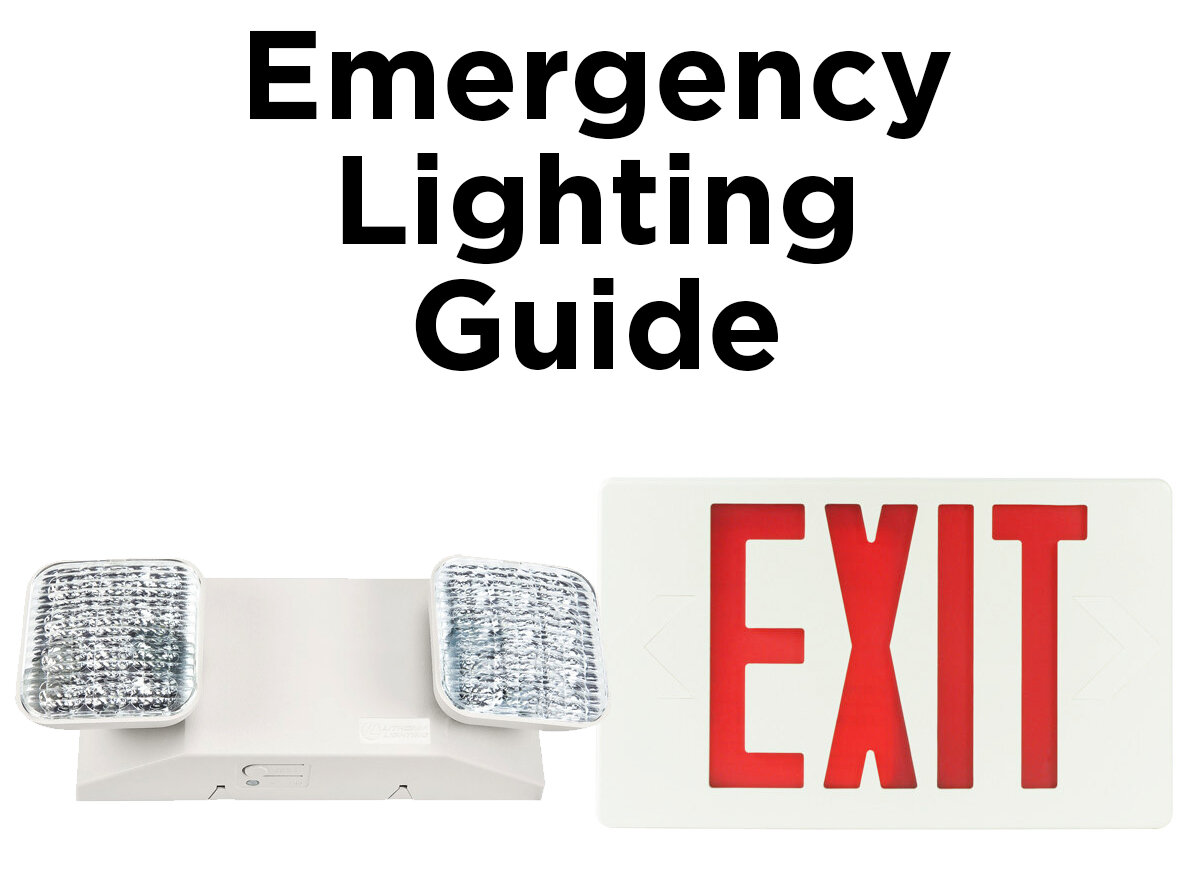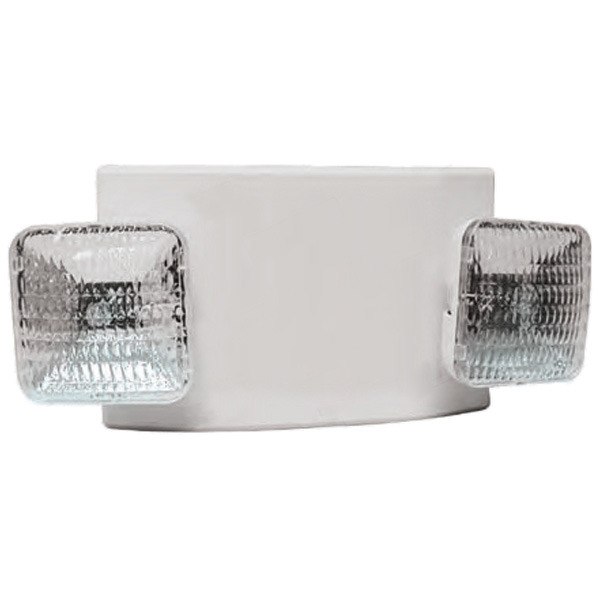Emergency Lighting Guide
Are you opening a new business or planning a shiny, new remodel of an existing place of business? One of the things you'll have to consider is emergency lighting, whether you want to or not. Emergency lighting is generally broken down into two parts: exit signs and emergency lights. Exit signs denote ways to safely leave a building during an emergency, while emergency lights are special lights that come on in the event of an emergency or power failure.
While no business owner wants to think his or her business might suffer a fire or other emergency, it is important to prepare for that contingency anyway. Insurance companies demand it and most local fire codes make it a requirement. There's good news however; despite being a technical subject, federal guidelines on emergency lighting boil down to the contents of only two key documents: OSHA 29CFR and NFPA 101 (also known as the Life Safety Code). If those sound like challenging reads, they are, but this introductory article should help you get started.
Requirements for Exit Lights
Let's start with a question: How many exits does your place of business have? Every one of those exits will need an exit sign. The requirements here are simple. The exit sign must legibly state the word "EXIT" in letters at least 6 inches high and with a 0.75 inch stroke (29CFR 1910.37(b)(7)). That's easy; in fact, you would be hard-pressed to find an exit sign in the United States that doesn't meet those requirements.
Unfortunately, that's the only easy part. There's no point in having an exit sign if your employees can't see it, is there? Your exit signs must be fully illuminated, either by an external light source or by internal illumination. Save yourself some trouble here and go with internal illumination. Using an external light source requires a whole new list of rules that, trust us, you don't have time for. Besides, with all the pre-approved, self-luminated exit sign options available—LED, Tritium, even photoluminescent (glow-in-the-dark)—why would you use anything else?
Though a little light goes a long way, even with the brightest exit sign, you've still got the problem of corners, hallways, and winding corridors. OSHA also requires that, unless the exit sign is in plain sight from every point in the building (good luck with that) you'll need additional signs with arrows that point the way to the door (29CFR 1910.37(b)(4)). Fortunately, most exit signs available today do double-duty as both an exit sign and a directional sign. To make your exit sign a directional sign, simply punch out the "chevrons" on either side of the unit and mount the sign to point in the appropriate direction. Only in very high-end "designer" exit signs will you need to order a special unit with pre-applied or etched directional arrows.
Note: Depending on where you live, there may be restrictions on letter colors set by the state or city. Check with your local fire marshal to make sure you have the correct color.
Requirements for Emergency Lights
The portion of OSHA 29CFR dealing with emergency lights (1910.37(b)) is relatively vague. It simply states, “Each exit route must be adequately lighted so that an employee with normal vision can see along the exit route.” NFPA 101, on the other hand, is much more specific. In section 7.9.2.1, it states:
The emergency light must provide illumination for no less than 1-1/2 hours.
The initial illumination of the emergency light must be an average of 1 footcandle (10.8 lux).
If you are unfamiliar with footcandles, essentially what the NFPA's requires is that the light cast on any one square foot of an exit pathway must be equal to one lumen or more (a footcandle is equal to one lumen per square foot). This is something you’ll need to consider when choosing your emergency lights and why many of our lights include photometric charts. An emergency light with typical 5-Watt tungsten heads may be appropriate for typical applications, but in many cases you may need one with halogen heads or even a special high wattage emergency light.
NFPA 101 also includes specific language about testing your emergency lights. Section 7.9.3 states:
A hard-wired emergency light must be tested monthly for a minimum of 30 seconds.
A fully battery-operated emergency light must be tested yearly for a minimum of 1-1/2 hours.
For the sake of convenience, not to mention safety, we highly recommend using self-testing emergency lights. These units continuously monitor the input voltage to the fixture as well as the condition of the battery backup. Should the fixture fail a test, an indicator light will signal that it needs to be serviced. At that point, you can choose whether you need to troubleshoot the input power or replace the fixture altogether.
Other Considerations
Emergency Ballast
Items not covered in NFPA 101 but still worth considering include remote capability, emergency ballasts, and aesthetic considerations. Remote capability allows you to connect multiple emergency lights, exit signs, or remote heads together, which will all trigger in the event of an emergency. Emergency ballasts keep fluorescent lights operational in the event of a power failure. An important option for exit signs is an internal battery backup. Only coming on when power is lost, these battery backups usually provide up to 90 minutes of power to keep the sign lit and recharges once power is restored. These batteries cannot be accessed, so the exit sign will need to be replaced when the battery reaches the end of its life.
Finally, you may want to consider the color and style of the emergency light or exit sign you choose; after all, it will become a part of your décor. Typical white thermoplastic exit signs and emergency lights work fine on white or off-white walls, but with darker walls (movie theaters being an obvious example) black thermoplastic units look much better. If you run a hotel or an upscale retail store, an exit sign with a brushed aluminum face or even an elegant edge-lit exit sign is a better option. Plus, with any LED exit sign you've got the choice of red or green letters.
Maintenance
Proper emergency lighting does not end with installation. Existing exit lights, safety lights, and emergency signage must be kept in good working order and occasionally updated to meet new fire codes. This means testing battery backups on a regular basis, replacing light bulbs when they burn out or break, and even performing regular cleaning to make sure the lights will give out the necessary amount of illumination when an emergency arises. For this reason, it is wise to find a reliable supplier of emergency lights that can help you with both new needs and ongoing maintenance requirements.
Do you have questions about the guidelines for emergency lighting? Leave them in a comment below or ask us on Facebook, Twitter, LinkedIn, and Pinterest.
Original post by 1000Bulbs.com Staff. Additional information added by Angela Rogers. Most recent update on 3/13/2019.







![Energy-Saving Light Bulbs [Video]](https://images.squarespace-cdn.com/content/v1/56feae0ab6aa60ebb6039bf3/1614622785582-68NXF624BFJA1ZTG1USL/Energy-Saving+Light+Bulbs.jpg)


